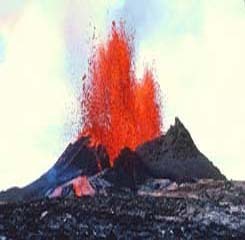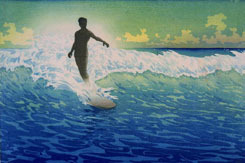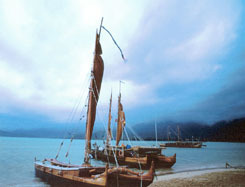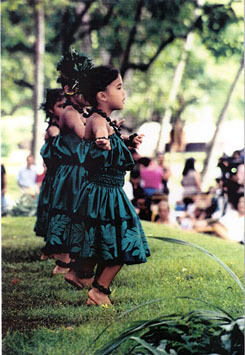
- Capital City:
- Honolulu
- Nickname:
- Aloha State / Paradise of the Pacific
- Motto:
- Ua mau ke ea o ka aina I ka pono (The life of the land is perpetuated in righteousness.)
- Statehood:
- August 21, 1959 (50th)
- Origin of State's Name:
- Possibly based on native Hawaiian word for homeland, "Owhyhee."
- Largest Cities:
- Honolulu, Hilo, Kailua, Kaneohe, Pearl City
- Border States:
- None
- Land Area:
- 6,423 sq. mi.; 47th largest
- State Bird:
- Nene (Hawaiian goose)
- State Flower:
- Pua Aloalo (hibiscus brackenridgei)
- State Tree:
- Kukui - Candlenut (aleurites moluccana)
- State Song:
- Hawaii Ponoi - Hawaii's Own
Known as the "Aloha State" (in Hawaiian, "aloha" means "hello"), Hawaii is a group of volcanic islands in the central Pacific Ocean that together became the 50th state in 1959. The state's name is possibly derived from a native Hawaiian word for homeland, hawaiki or owhyhee. Today, Hawaii, whose capital is Honolulu, is often called the "Crossroads of the Pacific" and is a popular vacation spot. The colorful hibiscus is the state flower.
King Kamehameha Celebration
>
Did you know that a long line of monarchs once ruled Hawaii? King Kamehameha I was one member of this royal line. He was born in North Kohala on the island of Hawaii, and it's estimated that he was born between 1740 and 1758. His childhood was spent in seclusion with foster parents who trained him in the skills of warfare and prepared him for his role as warrior-king of the island nation.
Although Kamehameha lived at the same time as Napoleon and George Washington, they were very different kinds of rulers, mainly because of how different their cultures were. During King Kamehameha I's reign, there was no written language, and the Polynesian religion that was practiced was called Hoomana. This religion was based on a group of gods similar to those of the Romans and Greeks.
Kamehameha I was a very successful king and ruled in peace. He accomplished a great deal by establishing trade with foreign countries, introducing new animal and plant life, and promoting agriculture and industry.
King Kamehameha I died in 1819. Today, every June 11, the giant statue of King Kamehameha shown here is decorated and festivities include parades on every island, arts and crafts fairs, sports challenges, pageantry, and an international hula competition.
Even Royalty Surfs in Hawaii

Did you know that in Hawaii's early days, when it was ruled by royalty, even kings and queens surfed?
Surfing is considered part of modern American pop culture, but the sport actually developed centuries ago in Polynesia in the Pacific Ocean. It was later brought to Hawaii in the eighth century. Petroglyphs (rock paintings) have been found in Hawaii that show early Hawaiians riding the waves. British explorer Captain James Cook made the first mention of surfing in print in his account of his journey through the Pacific Ocean. Even the early kings and queens of Hawaii participated in the sport. American writers Mark Twain and Jack London are known to have tried surfing. Duke Kahanamoku, who was born in Hawaii, was a gold medalist in swimming at the 1912 Olympic Games. He is commonly credited with the rise in popularity of surfing in the 20th century.
Hawaiian Canoe

Have you ever been in a canoe? Can you imagine traveling across the ocean in one? When Captain James Cook asked, "How shall we account for this nation having spread itself to so many detached islands so widely disjoined from each other in every quarter of the Pacific Ocean?" as early as the 18th century, he was wondering specifically about the Polynesian people. How did they get to so many islands spread so far apart? Perhaps the answer lies in the Hawaiian canoe.
Canoes served several purposes for early Hawaiians. Can you guess what some of them might be? Smaller canoes were used for traveling around the islands, while larger canoes were used for long-distance traveling or warfare. Fishing was also done from canoes. And, just like today, canoes were used for sports and recreation.
Hawaiian canoes were made of acacia koa, a tree that is now very scarce. Canoes were historically built by master craftsmen who oversaw all aspects of the process, from selecting the trees to getting the boat into the water. Lashing, or binding, of the pieces of wood was done with coconut or vegetable fiber.
Prince Lot Hula Festival

Did you know that you can tell stories with a dance? That's what the kids in the photo are doing when they do the hula, a traditional dance of Hawaii. The hula combines flowing movement with facial expressions, all set to special chants and music. When hula began it was a form of worship.
Prince Lot Kapu`aiwa kept the hula alive in Hawaii at a time when interest in it was fading. Can you guess how he did it? The prince, who later became Kamehameha V, King of Hawaii from 1863 to 1872, was noted for his energy and strength of will. One of his interests was to promote and preserve Hawaiian culture, especially the hula. He did this by holding hula performances at his cottage in Moanalua. To many, the hula represents Hawaiians' view of the world.
In appreciation of Prince Lot's efforts to preserve Hawaiian culture, the Prince Lot Hula Festival was established in 1978. Each year na halau (hula schools) come to the festival to perform at Moanalua Gardens in Honolulu. This festival also includes other Hawaiian activities and exhibits such as hand-stitched quilts, leaf-weaving demonstrations to make hats and baskets, instrument-making and lei-making (a lei is a necklace of flowers).
 Print
Print Email
Email







